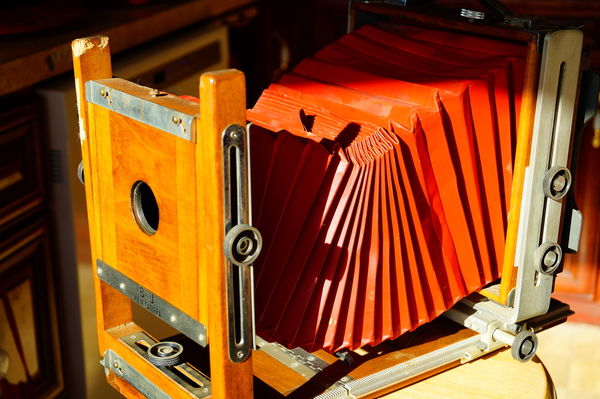Keystone effect
Jul 6, 2019 15:51:21 #
PhotogHobbyist wrote:
Rather difficult to do when photographing multi story buildings.
Difficult but not impossible. When I was a working architectural photographer it was a challenge in the cities to correctly render tall buildings. As mentioned you can use a wider angle lens, keeping the camera level, and crop out unwanted foreground and side image. For a taller building, find another building that may give you a view of your subject building and ask to shoot from a window at a floor half the height of your subject building, or maybe from the roof of another building. Or rent helicopter airtime to shoot your building. These all can work to give you correctly rendered verticals, I've used them all.
Jul 6, 2019 15:54:06 #
Sorry to show my ignorance -- but -- what is a view camera? It was discussed in relation to tilting it to avoid the keystoning problem up front. From the context, I guess it is something not commonly used now, but I'm curious nevertheless -- Can I still my Panasonic point-and-shoot and get some of the same effect? Never thought of that, but it might help. Of course, tilting it up to shoot a tall building is what causes this problem in the first place.
Jul 6, 2019 16:31:25 #
Ringer wrote:
I have never learned to use Photoshop and I am getting along pretty well with the editing tools in Windows 10. However, keystoning is a problem I haven't been able to solve. Once years ago I had a simple "fix" that worked most of the time, but I didn't form a habit of using it and now I have no idea what it was. Does anyone recall such a thing? It was some combination of Shift or Control and a number or letter, I think. Any ideas without learning Photoshop??
Do you have Lightroom? It's easily fixed in the Develop module under Transforms.
Jul 6, 2019 16:49:03 #
In Photoshop Elements the tool is under Image>Transform>Perspective in the Edit part.
Jul 6, 2019 17:21:35 #
Ringer wrote:
Sorry to show my ignorance -- but -- what is a view camera? It was discussed in relation to tilting it to avoid the keystoning problem up front. From the context, I guess it is something not commonly used now, but I'm curious nevertheless -- Can I still my Panasonic point-and-shoot and get some of the same effect? Never thought of that, but it might help. Of course, tilting it up to shoot a tall building is what causes this problem in the first place.
You might have seen 'old timey' view cameras with a bellows. Modern ones are still sold. The main feature is that the front and back can tilt and shift independently so you can focus on different planes and adjust perspective and other very interesting things. Check out the links.
https://www.bhphotovideo.com/c/buy/Field-View-Cameras/ci/27/N/4288586273
https://www.largeformatphotography.info/
Jul 6, 2019 17:27:53 #
Ringer wrote:
Sorry to show my ignorance -- but -- what is a view camera? It was discussed in relation to tilting it to avoid the keystoning problem up front. From the context, I guess it is something not commonly used now, but I'm curious nevertheless -- Can I still my Panasonic point-and-shoot and get some of the same effect? Never thought of that, but it might help. Of course, tilting it up to shoot a tall building is what causes this problem in the first place.
A large camera usually capable of tilting the film back and/or the lens mount:
https://upload.wikimedia.org/wikipedia/commons/thumb/3/30/View_camera_2.svg/800px-View_camera_2.svg.png
Jul 6, 2019 17:31:19 #
Ringer wrote:
Sorry to show my ignorance -- but -- what is a view camera? It was discussed in relation to tilting it to avoid the keystoning problem up front. From the context, I guess it is something not commonly used now, but I'm curious nevertheless -- Can I still my Panasonic point-and-shoot and get some of the same effect? Never thought of that, but it might help. Of course, tilting it up to shoot a tall building is what causes this problem in the first place.
It is a camera that uses either sheet film that is 4" x 5" or larger, or can accept roll film, typically 120 or 220. The front and rear of the camera are called "standards" and have "movements" that allow you to shift/tilt up/down and left/right, to precisely control perspective and depth of field. No, a point and shoot camera won't give you the same result, but if you don't mind an image of lower resolution (fewer pixels) you can digitally simulate the type of correction that can be done optically with a view camera.

Jul 6, 2019 18:04:07 #
Ringer wrote:
Sorry to show my ignorance -- but -- what is a view camera? It was discussed in relation to tilting it to avoid the keystoning problem up front. From the context, I guess it is something not commonly used now, but I'm curious nevertheless -- Can I still my Panasonic point-and-shoot and get some of the same effect? Never thought of that, but it might help. Of course, tilting it up to shoot a tall building is what causes this problem in the first place.
This is a View Camera - a Burke and James 5x7 … I also have a 4x5 …
5x7 View Camera aka Field Camera


Jul 6, 2019 18:08:27 #
Gene51 wrote:
It is a camera that uses either sheet film that is... (show quote)
Gene - there are many View Cameras which use smaller sheet film than 4x5 - go look at Sinar's site.
The important thing to note is they all use a bellows - which can be adjusted at whim, to eliminate converging lines in the subject, plus adjust for other potential distortion, as well …
Jul 6, 2019 18:19:14 #
bleirer wrote:
You might have seen 'old timey' view cameras with a bellows. Modern ones are still sold. The main feature is that the front and back can tilt and shift independently so you can focus on different planes and adjust perspective and other very interesting things. Check out the links.
https://www.bhphotovideo.com/c/buy/Field-View-Cameras/ci/27/N/4288586273
https://www.largeformatphotography.info/
https://www.bhphotovideo.com/c/buy/Field-View-Cameras/ci/27/N/4288586273
https://www.largeformatphotography.info/
Ah -- interesting! I had no idea -- I'm sure my Dad would have known. He was an excellent photographer in the pre-digital age!
Jul 6, 2019 18:27:13 #
Ringer wrote:
Ah -- interesting! I had no idea -- I'm sure my Dad would have known. He was an excellent photographer in the pre-digital age!
Some pre-digital Medium Format Cameras - like the Mamiya RB67 - also, used a bellows …
It allows you to correct all perspective problems … in order to do that, currently - with DSLRs - you need a P/C (Perspective Control) Lens. Both Nikon and Canon have versions, in their line-up. But, you will NEVER have the same kind of control, with a lens, you have with a View Camera ….


Jul 6, 2019 18:58:27 #
I seem to recall a command in PSE ( Elements ) called "Skew" for correcting the keystone effect.
Jul 6, 2019 20:52:55 #
will47 wrote:
What is the Keystone effect?
Non parallel vertical lines when photographing structures and buildings with. There are correction programs within most software to address this.
Jul 6, 2019 22:01:49 #
Ringer wrote:
I have never learned to use Photoshop and I am getting along pretty well with the editing tools in Windows 10. However, keystoning is a problem I haven't been able to solve. Once years ago I had a simple "fix" that worked most of the time, but I didn't form a habit of using it and now I have no idea what it was. Does anyone recall such a thing? It was some combination of Shift or Control and a number or letter, I think. Any ideas without learning Photoshop??
Keystoning and parallax are opposites but occur when the focal length is short and the camera is angled from the obviously tall object. Keystoning makes the building look as if it will fall forward. Parallax makes the building look like its leaning back. You could hold the camera off to one side and use one of the
edges in the view finder as a vertical level. You may have to raise the camera over your head and tilt it downwards. That doesn't always work. E.L. Shapiro recommended a tilt shift lens. This lens will change the perspective somewhat. You definitely need a tri-pod and not a mono-pod. Their use is somewhat limited and may not justify the hefty price tag. I have one and use it occasionally. Try renting one to become familiar with it. As for post-production, I'm not really familiar with the fancy new computer programs. I will need to take some time to learn them. Perhaps a Hogger can give their experience with computer programs and I will offer some tilt-shifted photographs.
Happy Shooting!
Jul 6, 2019 22:05:20 #
Scruples wrote:
Keystoning and parallax are opposites but occur wh... (show quote)
The best comparison definition I've heard.

If you want to reply, then register here. Registration is free and your account is created instantly, so you can post right away.





